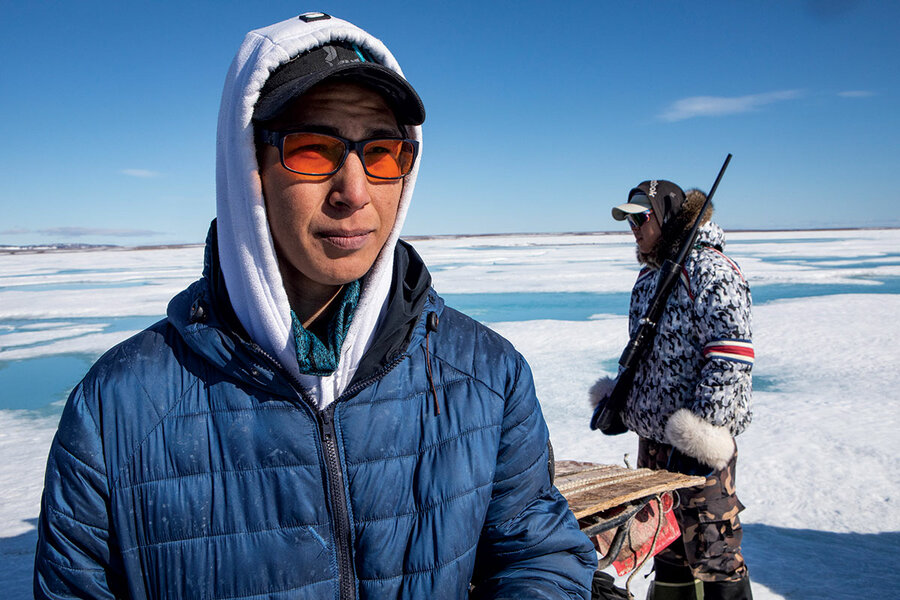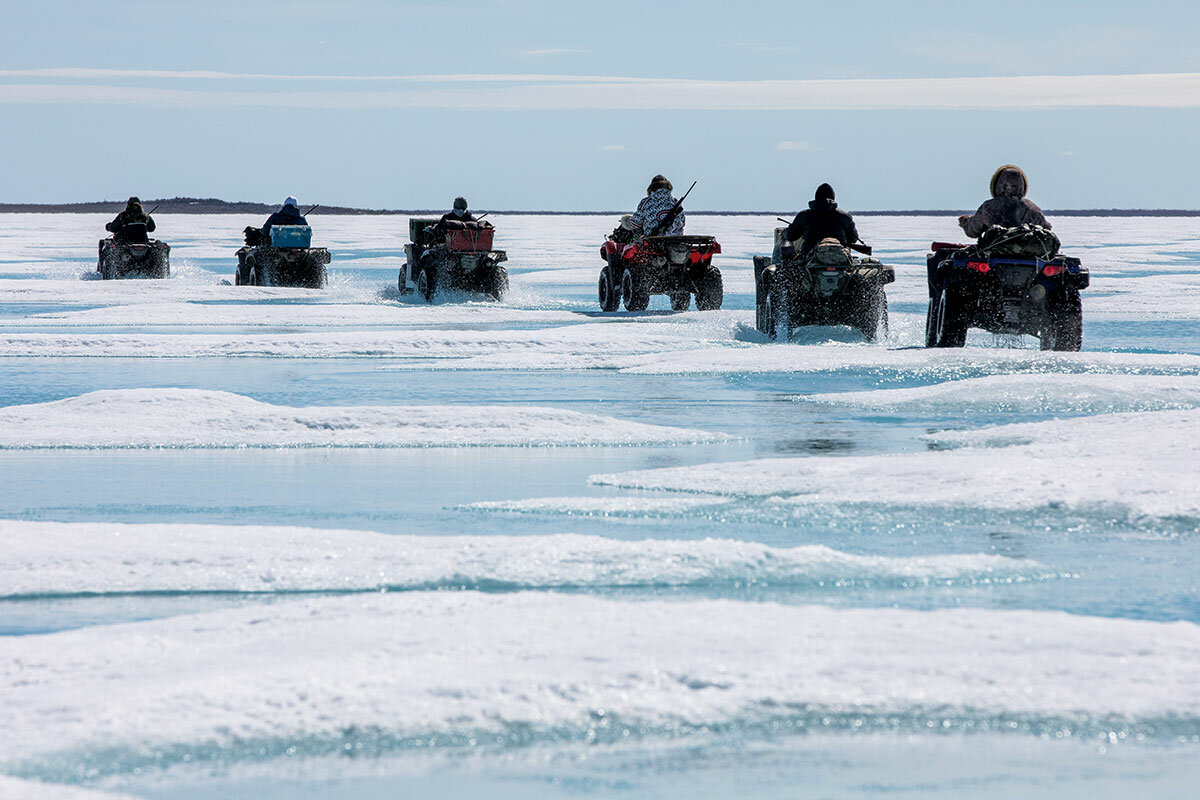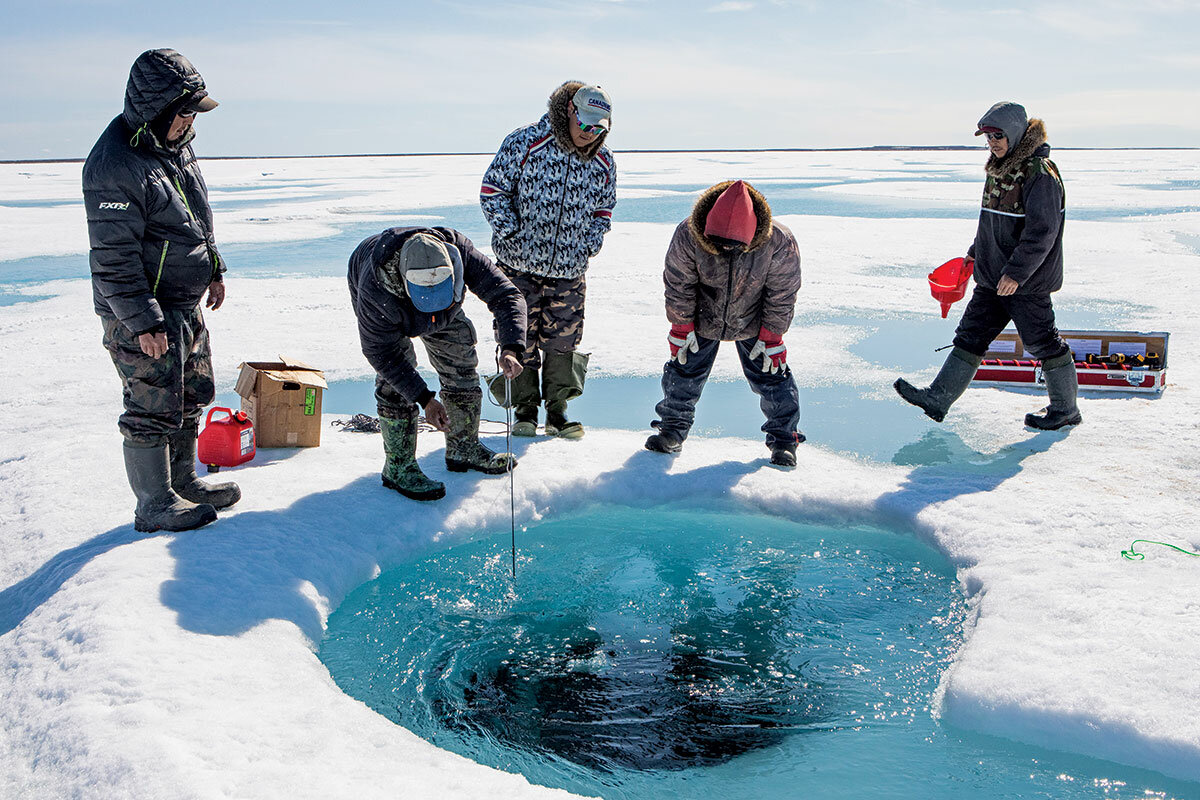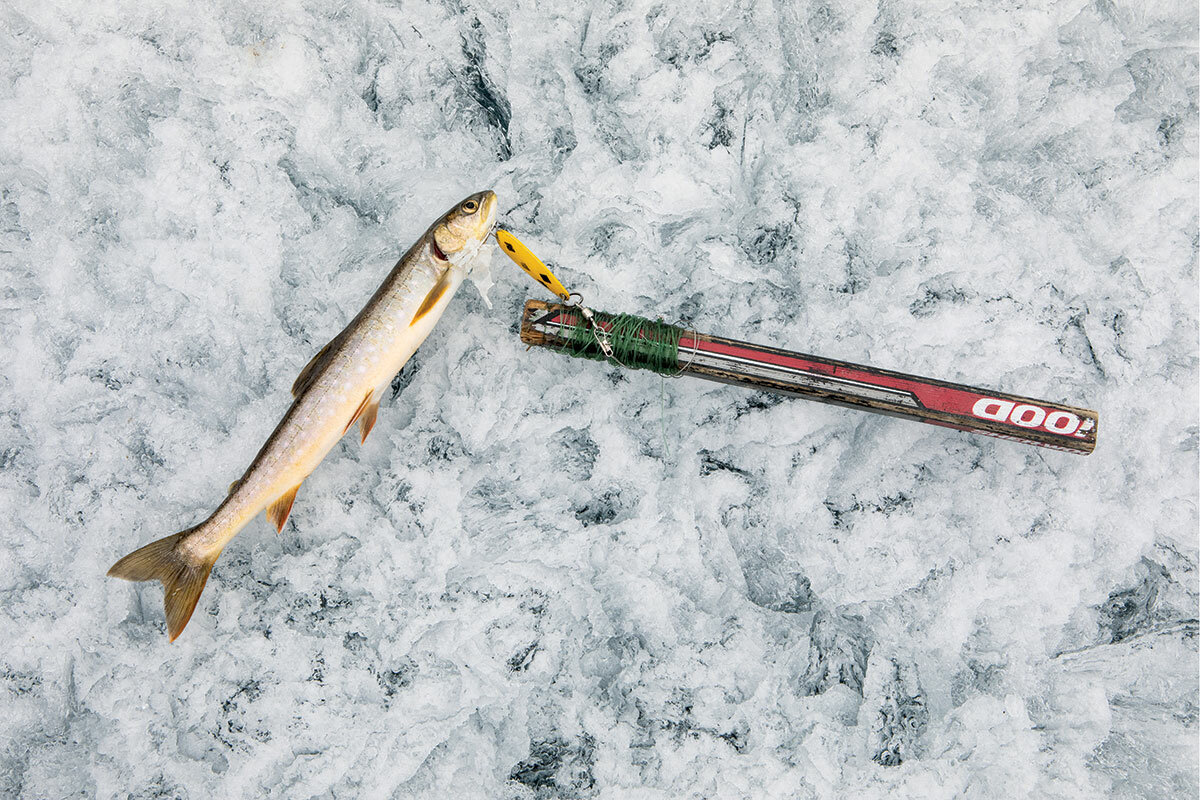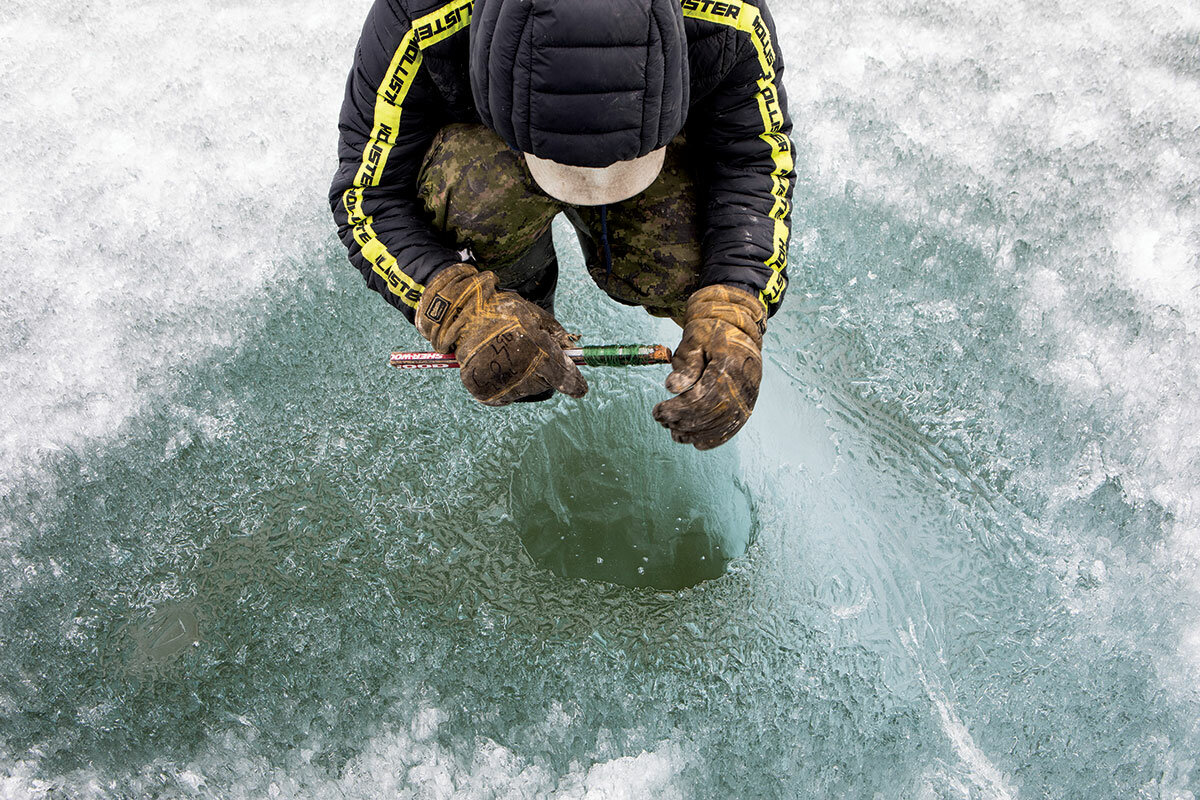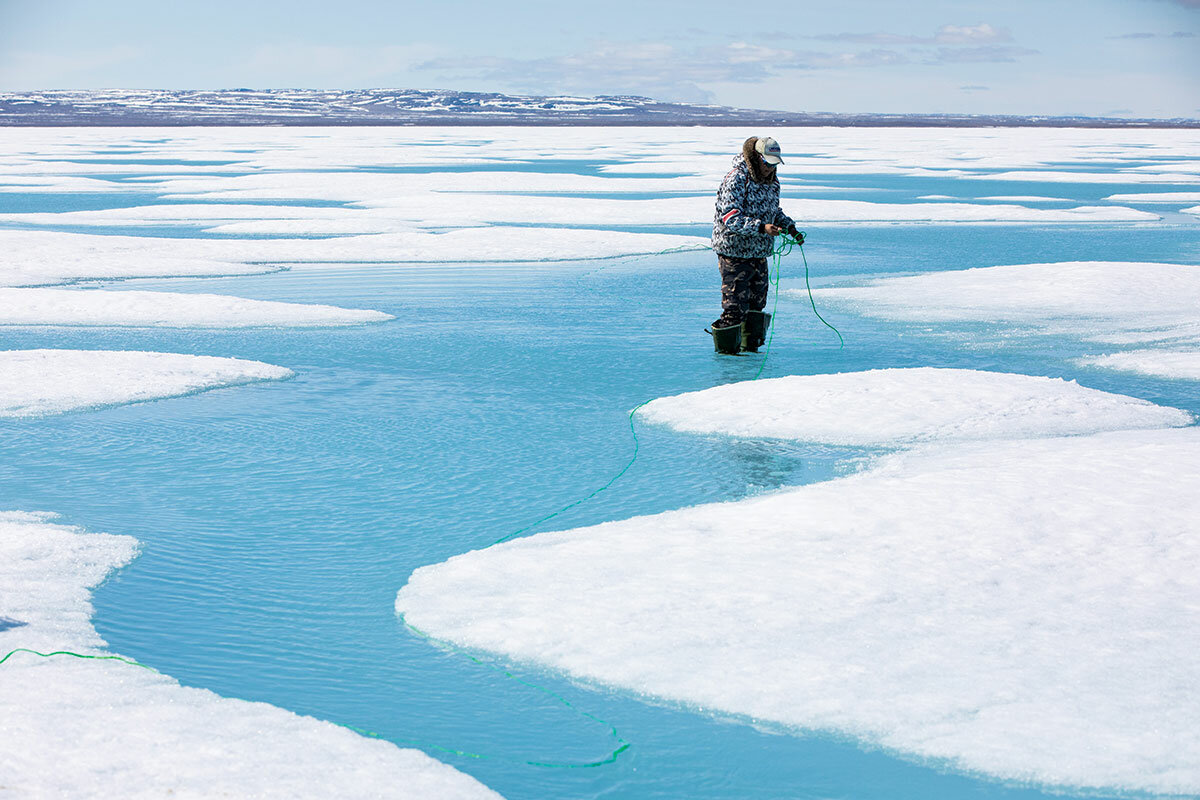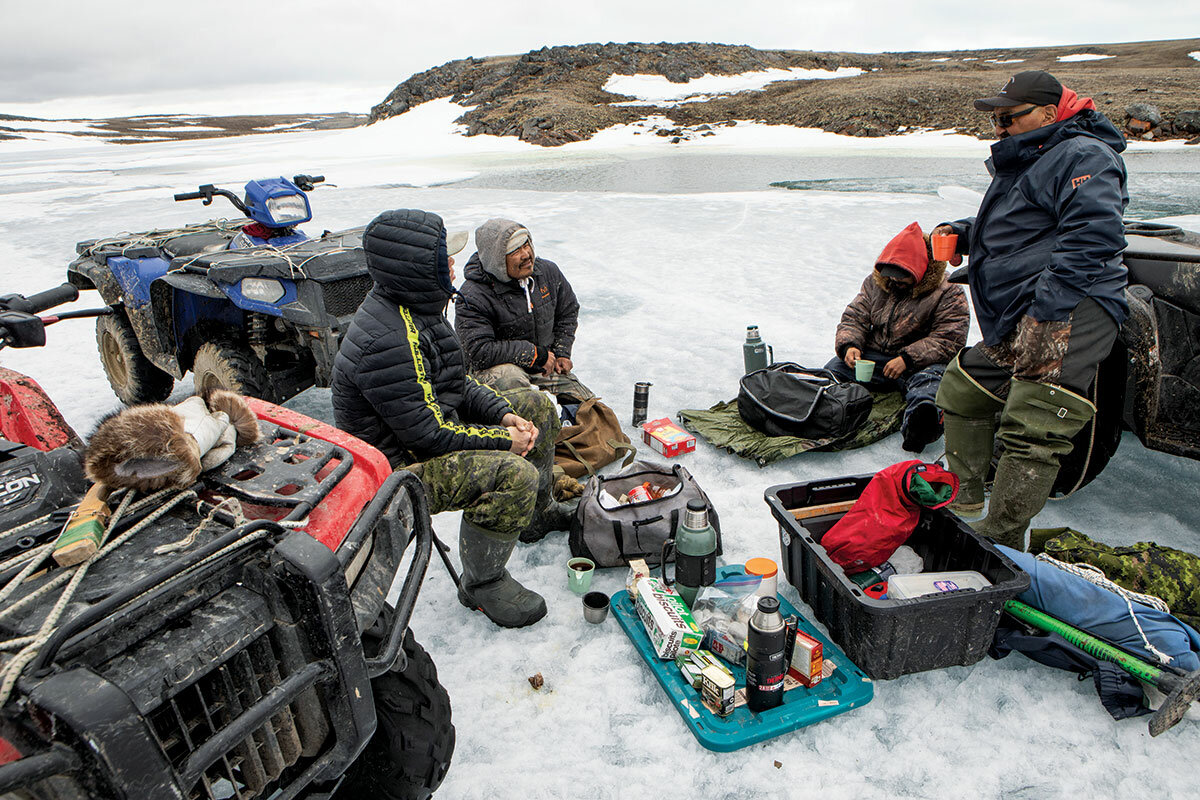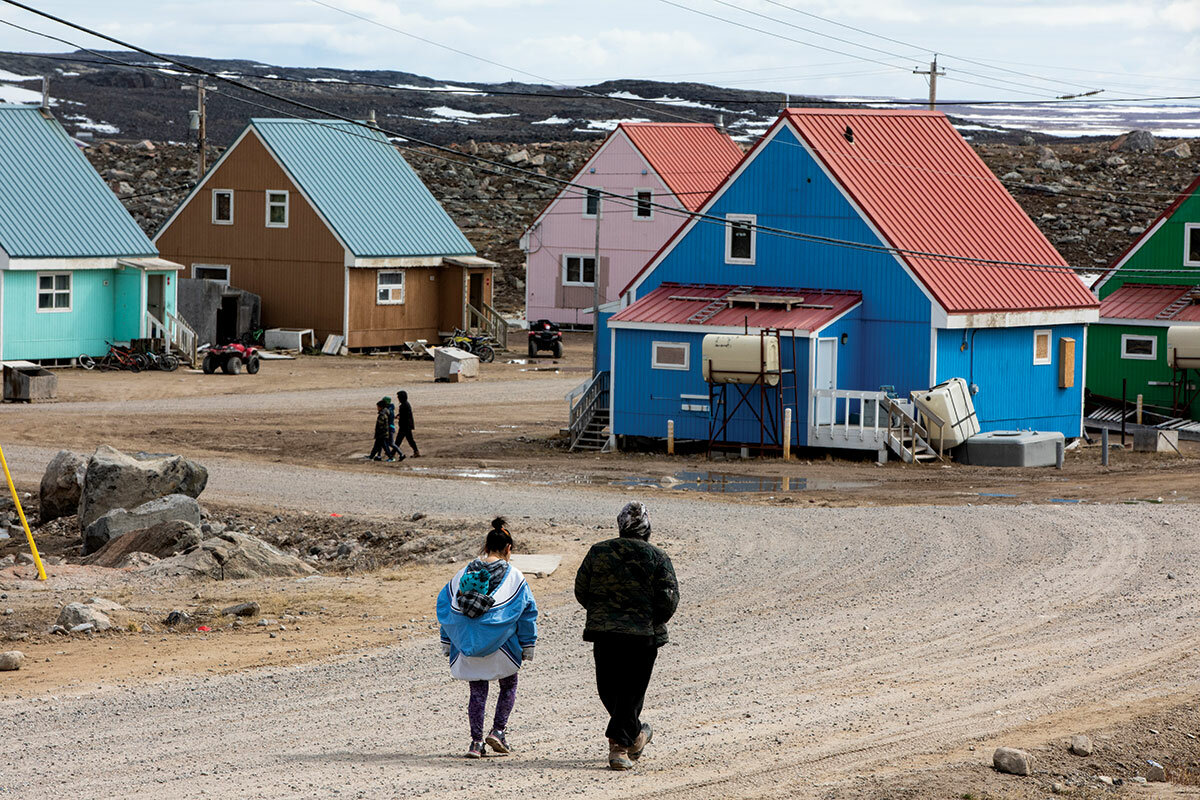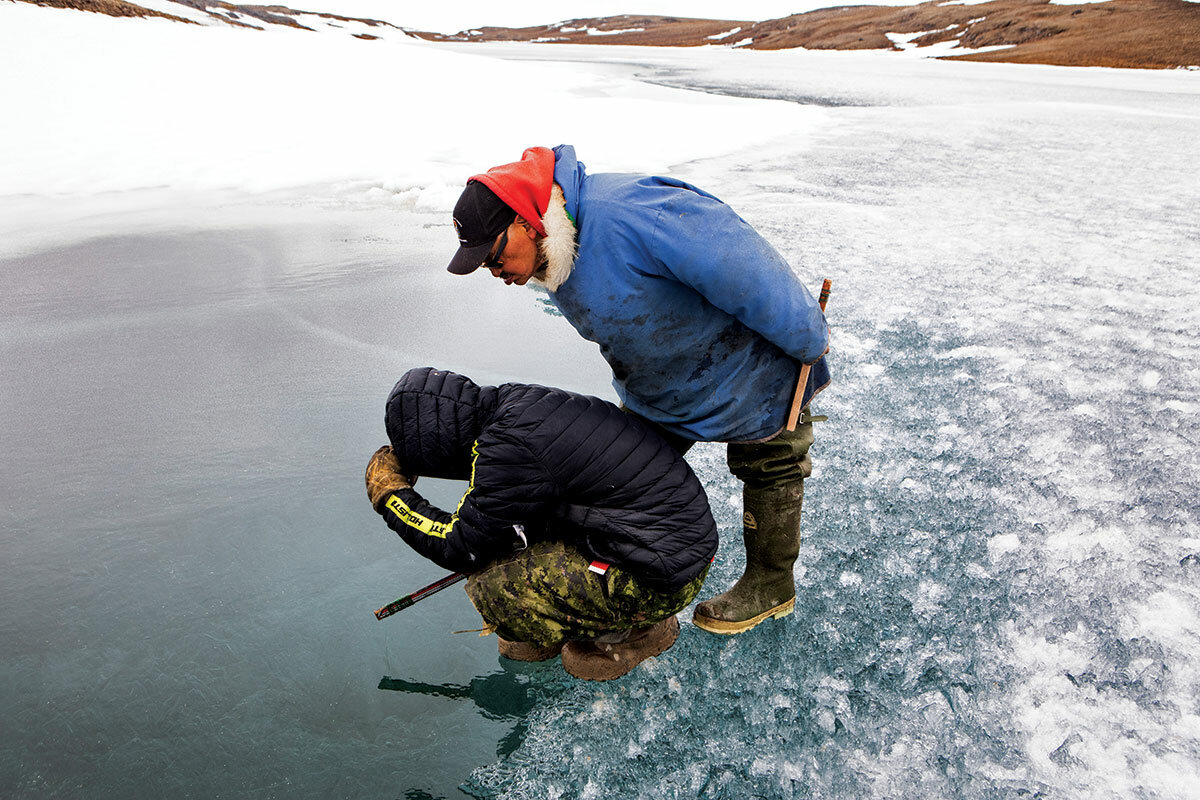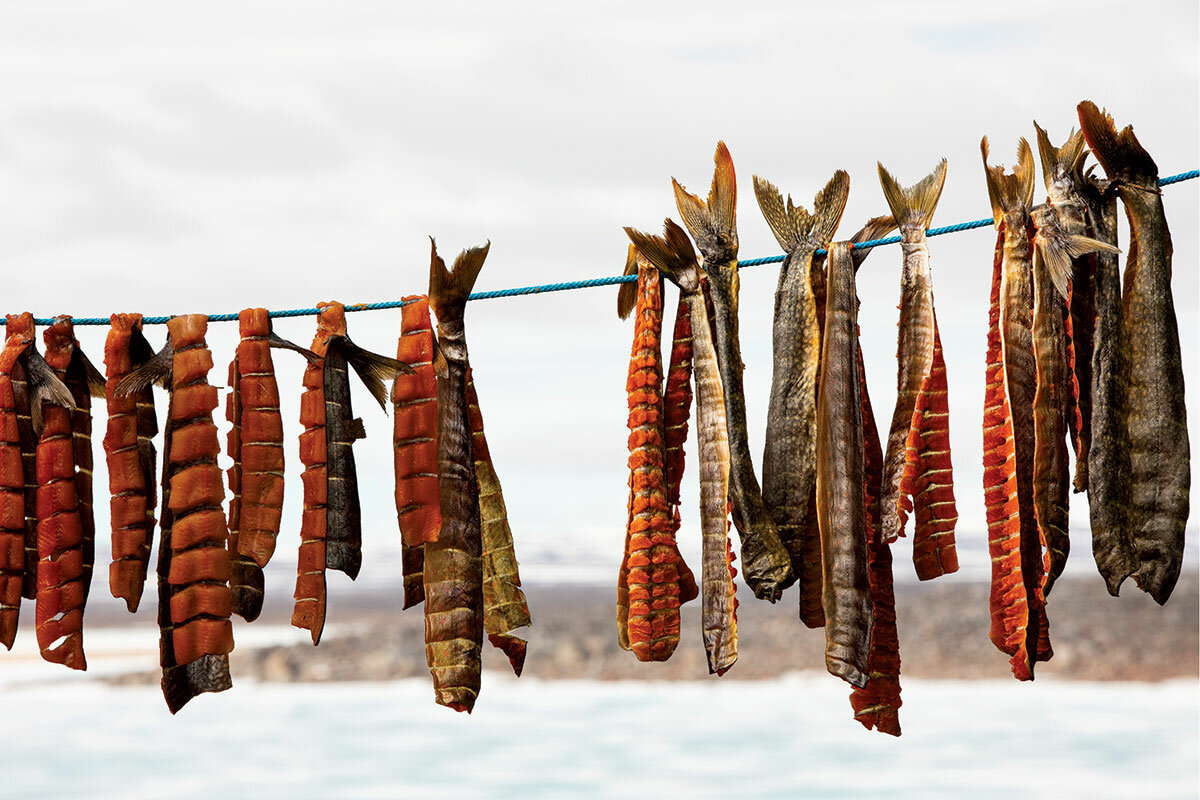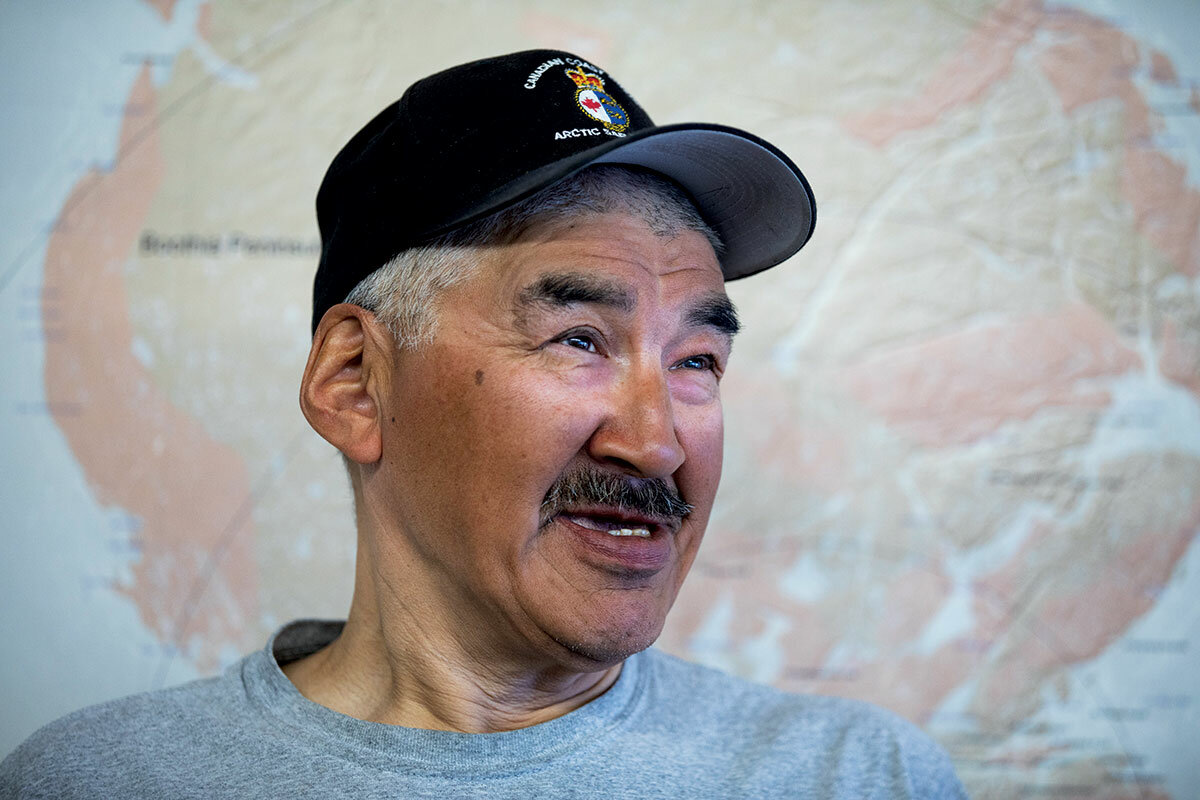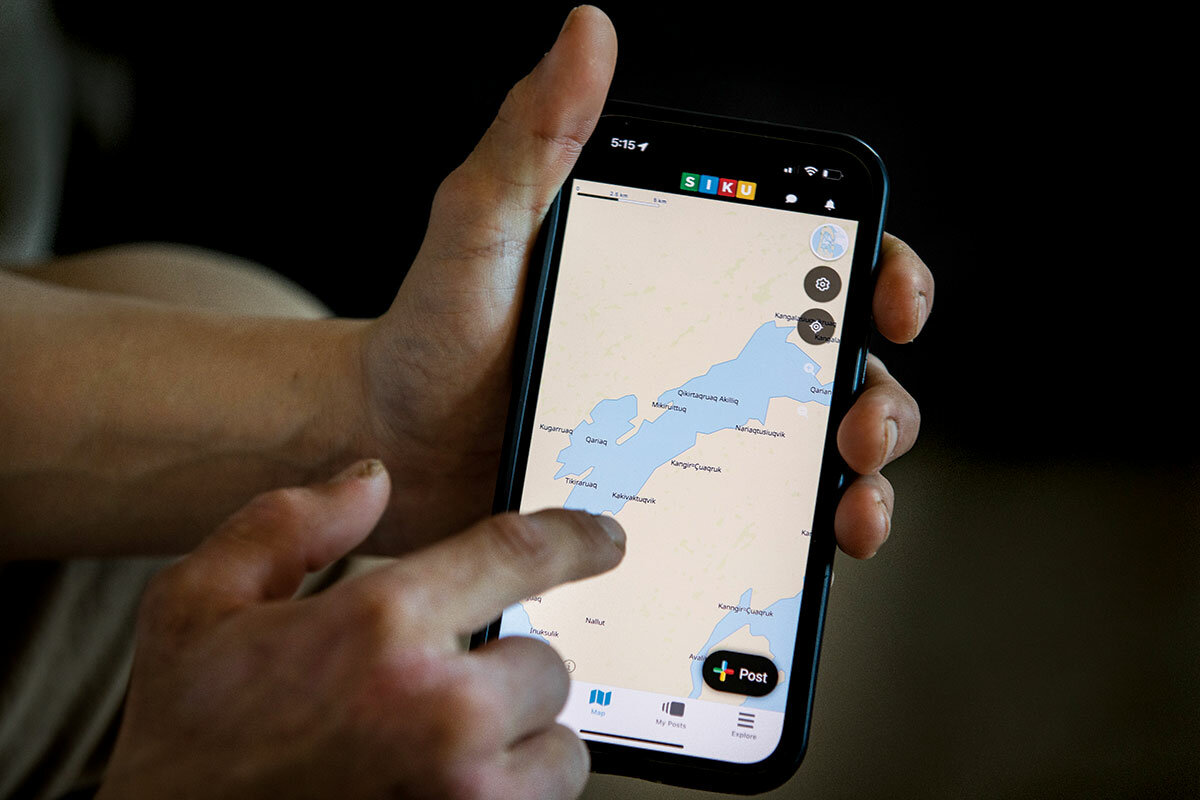Indigenous Guardians protect their culture of cold in a heating world
Loading...
| Taloyoak, Nunavut
Masked against the Arctic glare in orange-tinted sunglasses, Tad Tulurialik is a modern conservation “Guardian” of his fast-melting homeland.
At the start of an early summer workday that never sees the sun set, he kicks his all-terrain vehicle into gear. Safe in his ancestors’ knowledge of sea currents and ice fissures, he navigates a course right off the edge of the Canadian shore onto the aqua iridescence of the frozen Arctic Ocean. He’s following older Guardians to a manmade hole in the ice shelf, a window toward understanding climate-related changes in the sea.
Even out on the ocean surface, his rifle is always swung over his shoulder. Wherever he sees a caribou or musk ox, it’s an existential given that he’ll take it. Food security isn’t found in a grocery aisle in this northernmost Canadian mainland settlement, tellingly named with the Inuktitut word for a caribou hunting blind.
Why We Wrote This
A story focused onA budding Arctic conservation economy combines ancient community knowledge with modern science to preserve the Indigenous “right to be cold.” Part 7 in a seven-part series.
In some ways, as a government-paid conservation Guardian in training, the 24-year-old Mr. Tulurialik is doing what he’s done his whole life. Like most Inuit boys, he was “on the land” as soon as he could walk. His childhood was spent on tundra and on sea and lake ice to hunt and fish with his grandparents, who raised him. His life was marked not by school grades but by first fox trapped, first polar bear shot. These were such priorities that he dropped out of high school.
That could have made him part of Canada’s persistent social inequality – Indigenous youth in some of the remotest parts of the country, undereducated, underqualified, and often losing touch with rich traditions and fleeing homelands for economic opportunity. Except today, he’s part of a solution, as a member of Canada’s Indigenous Guardians, a conservation corps working in 170 far-flung Indigenous communities.
Guided and taught by elders, he and other young Inuit born since 1989, when warming of the Arctic turned precipitous, are part of an effort to safeguard their homelands and their cultural “right to be cold.” They’re also helping Canada achieve international conservation commitments made last year, when it led a global pledge at the United Nations Biodiversity Conference in Montreal to protect 30% of its land and oceans by 2030.
For Mr. Tulurialik, who worked in construction and sewer maintenance after leaving school, a paid job as a conservationist is a dream: “I never thought I would work and get paid for what I grew up doing.”
Together, he and his Guardian colleagues are tasked with creating a sustainable future, transforming Western-style conservation work into something that more closely resembles a traditional Indigenous environmental ethos. Guardians blend science with Indigenous knowledge in a budding conservation economy dependent on the transfer of knowledge from elders to youth.
The ultimate aim of the Guardians’ work in Taloyoak is to use their sustainable Inuit practices – learned orally over millennia – to support the creation and maintenance of an Indigenous Protected and Conserved Area. The size of Maine, it is one of more than 90 in development across Indigenous Canada. Here in northern Nunavut territory, the IPCA conservation plan is led by the local hunter and trapper association; it’s nurturing an economy of land-based jobs and markets as an alternative to a future in extractive industries in a territory long eyed by mining and oil interests.
The land will be protected from development, conserving both biodiversity and a way of life based on sustainable hunting and fishing – while sequestering huge amounts of carbon, the culprit in global warming.
“This is a win-win situation where the government meets the national obligations of having protected areas as part of their commitment to the international community and the Inuit continue on with their traditional ways,” says Paul Okalik, the first premier of Nunavut who now works with Canada’s World Wildlife Fund (WWF), which is supporting Taloyoak’s efforts.
The Taloyoak team reaches its destination, having traversed shallow pools of glistening water and snow-crusted patches that have not yet acquiesced to the seasonal melt. The professional land stewards encircle the 6-foot-wide cavity descending through ice to swirling water below.
Mr. Tulurialik helps unload boxes of scientific equipment. He hands over a line of rope to help feed a net under the ice floor to gather algae and water samples. Data from the samples shapes a baseline to inform efforts to safeguard the fast-warming ecosystem.
Where 78 F is sweltering
Indigenous lands, from the Brazilian Amazon to Hawaii coastlines to Canada’s high-latitude forests, represent 20% of the globe but hold 80% of the world’s biodiversity. Inhabitants have stewarded the land for centuries. Yet in a warming climate, their homelands are in some of the most at-risk environments.
The Arctic is this nation’s – and arguably the world’s – crisis point. Here, warming is happening at up to four times the rate of the rest of the world, leading to melting permafrost, retreating glaciers, and receding sea ice. This has broad implications for the global ecosystem. Arctic ice melt slows ocean currents and makes the oceans more acidic – changes that have global implications for both climate patterns and sea habitats. Increased melting also creates what scientists call a “positive feedback loop”: As dark water replaces white snow on ice, the surfaces of the ocean and Earth absorb more sunlight rather than reflecting it. This causes even more warming.
The changes in the health of the Arctic – and the implications – are most obvious to those experiencing it day to day in the Canadian polar region. The Inuit and the wildlife they depend on here share a tightly intertwined habitat – including the summer calving ground of 50,000 Ahiak caribou and polar bear denning areas. The ocean is habitat for narwhal, beluga, and bowhead whales.
Climate change can disrupt the balance in multiple ways. Shorefast ice is a crucial platform for subsistence hunters and fishers across the Arctic, and a 2020 Brown University study shows Taloyoak faces some of the fastest rates of loss, projecting ice melt will be 44 days earlier in the spring by 2099.
Taloyoak locals have already worried about warming changing their ways. Last summer was the Northern Hemisphere’s hottest on record. The year prior, Taloyoak recorded its all-time hottest temperature of 78.8 F. Locals stayed home rather than go outside in, for them, the unbearable temperature.
Snow comes later in September; ice gets thinner, faster, in June. That, says Abel Aqqaq, lead Taloyoak Guardian, leaves the Inuit with “rotten ice.” Snow isn’t dense enough anymore to form snow houses, explains Mr. Aqqaq, who was born in an igloo some 60 years ago.
Ice melt opens more shipping routes in the Northwest Passage just above the Aviqtuuq Peninsula, where Taloyaok is perched. And that brings more human threats to the habitat balance. Extractive industries see iron ore, gold, diamonds, and oil and gas potential at the top of the world.
Climate change for the Inuit is “emphatically” a cultural issue, argues Inuit Nobel Prize nominee and activist Sheila Watt-Cloutier, author of “The Right To Be Cold.”
“Our hunting culture is dependent on a frozen North,” she writes in her book. “We Inuit simply cannot have personal freedom, we cannot have choice, if we don’t have the right to be cold, if our homeland and culture are destroyed by climate change.”
The eight paid Guardians of Taloyoak, who are all men in a society organized by traditional gender roles, include four youth in training who are in their late teens and early 20s. Together they have set out to understand the changes here.
They can’t stop the warming, but along with their Guardian counterparts across nearly 200 Indigenous communities, they are recognized and empowered by the government as the “eyes and ears” of land and ocean conservation.
Canada holds a third of the world’s boreal forests, a quarter of the world’s wetlands, and a fifth of the world’s fresh water, says Valérie Courtois, executive director of the Indigenous Leadership initiative.“It is of global importance that Canada expresses its leadership on environmental issues. And if Canada can figure it out, then maybe other parts of the world can figure it out, too.”
In that sense, she notes, with Guardians on the front lines of Canada’s fast-changing environment, the globe is dependent on the link they form in climate crisis response.
It represents a fundamental shift toward an Indigenous understanding of preservation – one that conceptualizes humans, animals, land, food, and culture as one integrated system, rather than separate sectors. That’s going to be necessary as the world faces the growing impact of climate change, says an expanding global collection of policymakers, scientists, and climate advocates.
The Guardians are being given a career opportunity with a strong future: Their work is the backbone of IPCAs and other Indigenous conservation efforts, which received $800 million (Canadian; U.S.$590 million) in funding during COP15 in Montreal last December.
David Orr, distinguished professor emeritus of environmental studies and politics at Oberlin College in Ohio, has been behind a U.S. effort to build dialogue about the connections between political systems and climate. “We’ve tended to do things in silos ... by departments and divisions,” he says. “But that’s not how the Earth works.”
Nor is it how the Inuit live.
Creating a conservation economy
The youth Guardians, part of what we are calling the Climate Generation, don’t label their work “conservation.” It’s a seamless expression and extension of their endangered lifestyle more than it is a conscious solidarity with the global climate movement.
Spread among 25 settlements across the Nunavut territory – a fifth of Canada’s landmass – the Inuit have an intimate connection to their homeland and a disconnection from the rest of the world that can’t be overstated.
An outsider visiting Taloyoak hamlet, above the Arctic Circle, might experience a sense of being trapped by its remoteness and insularity. There are no roads in or out – the nearest settlement is 85 miles away on an island. There are two grocery providers stocked with food that is sea-lifted annually from the south – but hunting is the main source of protein. There is a school, a hockey arena, and a basic hotel, but few other places to gather.
The town of 1,100 is composed mainly of 250 mostly government-subsidized houses that curl around the bay, some painted bright orange and purple. Ninety percent don’t own a house here – though many have built their own remote seasonal hunting cabins. “Home” here is less about the physical dwelling and the settlement than about the land itself.
It’s not surprising that members of Mr. Tulurialik’s generation here have never heard of the youth climate activist Greta Thunberg from another Arctic nation, Sweden. But caring for the land and wildlife – particularly caribou, which they call tuktu – is simply a part of their Inuit identity.
Summer days are a favorite time of year, not because it’s relatively warmer but because there is 24-hour sun. Entire families drive quads deep into the land at all hours of day and night, using every bit of daylight to catch arctic char and trout and dry it for the dark winter months ahead. They sleep when tired and eat when hungry.
On the summer solstice, a national holiday honoring Indigenous peoples, youth Guardian Hunter Lyall doesn’t rustle from bed until close to 5 p.m. At his home overlooking the bay, his lawn is an unselfconscious workplace full of all manner of engines, tools, and carcasses of hunted animals.
Although he and his friends spend most of their free time hunting, Mr. Lyall has an engineer’s curiosity about constructing and deconstructing – and the highlight and pride of his three years as a youth Guardian has been building a 16-foot rosewood cargo sled from scratch.
But he, like Mr. Tulurialik, also dropped out of high school – the lessons in animals’ names or geography felt pointless compared with hunting those animals and tracking that land. It’s practical know-how needed to feed the community here in Nunavut, Canada’s newest territory.
The Inuit-governed territory was founded in 1999 and was considered a capstone of Indigenous resurgence. But it suffers from legacies of colonization that forced nomadic hunter-gatherers into permanent settlements, rendering them dependent on a wage economy and the government. During the Cold War, Inuit communities were driven into the High Arctic to assert Canadian sovereignty. The government slaughtered their sled dogs and sent their children to residential schools. Today, the territory has Canada’s highest poverty rate (30%) and lowest high school graduation rate (57%).
As they do anywhere, young people with big dreams do leave. But leaving isn’t as simple for the young here as it might be in small-town Ontario or Iowa. Cost of travel is prohibitive; most only board airplanes when they need to fly out for medical services. And raising families starts early here. Many of the youth Guardians, like the 19-year-old Mr. Lyall and Mr. Tulurialik, already have small children of their own, and rely on extended family to help raise them.
The pull of tradition bonds families and interests those who do stay, but it’s increasingly too expensive to pass down. Mr. Lyall’s father, Henry Lyall, taught him to hunt. And the first arctic fox the boy shot – at age 7 – is proudly mounted and displayed in his parents’ living room. But now the elder Mr. Lyall works during the week as a heavy-machine operator for the hamlet of Taloyoak, so he no longer has time to support his family from the land. His wife and daughter knit fur-lined mittens and headbands for sale – which helps pay for fuel, ATVs, guns, and bullets.
Though the elder Mr. Lyall wasn’t pleased when his son quit school, he says the Guardian program has created a path forward: “This is good for him, that he’s got other elder guys to look up to and show him what goes on. And you know, the climate is changing so the ice conditions are getting more dangerous. So they gotta be taught.”
“I’m very proud of him. It’s who we are, and what we need to grow,” adds his mother, Viola, who posted proudly on Facebook about his first beluga whale, harpooned with the Guardians in August. “This is the way we choose to live our lives.”
That choice – to create a viable conservation economy here – makes them valuable to Canada and the world.
Guardians help “re-identify” Indigenous culture
Choice among Indigenous peoples isn’t monolithic, of course. There are debates about responses to climate change, pitting the pure economic value of extractive development against the modest sustainable subsistence tradition. In Nunavut, four mines currently extract iron ore and gold. For decades they’ve provided thousands of paying jobs, injecting cash – and environmental disruption – into some Inuit communities that depend on a healthy habitat for subsistence hunting.
“I don’t want [development] to affect my land or where it’s populated with wildlife. That’s going to affect hunting for generations,” says Mr. Tulurialik. “I want the land to be as natural as possible for my kids and their kids.”
And that’s where the IPCA – and a conservation economy – come in as an alternative to extractive industries and as a future for him and his children.
The old Western model of conservation, alone, won’t work unless it includes a vision from the people, maintains Canada’s
WWF, which provides organizational and administrative support to Taloyoak’s IPCA. Well-paid jobs in conservation can compete with the shift work at mines that takes residents away from their communities for long periods of time or to the south, says Brandon Laforest, WWF Arctic specialist. “They are land stewards. And they deserve compensation to do this conservation,” Mr. Laforest says.
Salaries are paid by various federal supports and grants. Along with a patchwork of other funding, the Guardians of Taloyoak have received $3.53 million (Canadian; U.S.$2.4 million) from the Department of Fisheries and Oceans to monitor the marine environment, create small-scale fisheries for commercial sale, and outfit camps for tourism.
These are the kinds of jobs that Inuit societies need, says Corrine Boisvert, a kindergarten teacher at the local school: “They are more along the reality of our lives, because any other job is something that was brought, like a false economy. This is a hunting and harvesting lifestyle. That’s self-sustaining here. It’s not, ‘Oh, I might not have this job next week because the co-op’s closing.’”
At the heart of it is food – and the provision of meat – which is central to Inuit survival and kinship. The local hunters, who distribute their catches to those in need from the community’s shared freezer, won a $451,000 prize for a project called Niqihaqut, or “our food.” It would ensure support for the Guardians’ sustainable production of hunted and land-gathered “country food” for commercial sale – with plans for a cut-and-dry facility that would create new jobs.
The cultural resurgence inherent in Guardians’ work makes it much more sustainable than an adherence to climate goals alone, argues Ms. Courtois of the Indigenous Leadership Initiative. The Guardians, she suggests, are a “force of re-identification” for Indigenous peoples – their knowledge and culture, once disregarded by policymakers, becomes a solution for Canada, and not a problem to be solved.
“Two-eyed seeing”
The Guardian model is based on a constant transfer of knowledge – from Indigenous to non-Indigenous and from older to younger – that in many First Nations is called “two-eyed seeing.” In Inuit culture, it is based on the incorporation of Inuit Qaujimajatuqangit, or traditional values, into some of the most cutting-edge science in the north.
This melding of old and new creates expansive opportunities for young Guardians Tulurialik and Lyall.
Maybe in spite of himself, says Mr. Tulurialik, who left science study behind, he has most enjoyed learning how to sample species or sea salinity. But it’s not a scientist’s curiosity so much as a cultural duty to keep his community safe.
The Guardians have been trained by the Canadian Coast Guard – another highlight for Mr. Tulurialik was learning how to operate a small vessel and do search and rescue. When his nephew ran out of gas far out on the tundra last year, the young Guardian put those skills into practice, calmly gathering proper supplies and equipment for the five- or six-hour search in the dark.
When the Guardians go “south,” Mr. Aqqaq says they always include a youth. Taloyoak’s Guardians chose to send Mr. Lyall to Quebec with the elder Mr. Aqqaq to learn how to use cameras to monitor the caribou.
And the technological savvy of young digital natives bolsters scientific research on new weather patterns and changes that have upended ancestral knowledge.
Mr. Aqqaq, sitting on an ATV on a frozen lake, wags his fingers in a typing gesture: The young Guardians, he says, “have got more knowledge on electronic gadgets” than the elders. Indeed, as Mr. Aqqaq was trying to put his finger on the name of the lake he’s always fished from, Mr. Lyall literally puts his finger on it – via Siku, a GPS app that identifies traditional place names and collects community monitoring of wildlife and ice conditions.
But then there are the moments when the young Guardians receive knowledge that no app or gadget can produce.
On this day, Mr. Aqqaq, who retired from the Canadian Rangers after 37 years, leads the men and boys through an expanse of sloping tundra, beige with splashes of lime-green, yellow, and orange lichen clinging to rocks.
They stop to search the tundra for snow goose eggs before arriving at the lake, where the edges have started to melt and natural fishing holes form, leaving an ice sheet that at points is as sharp as lava rock. A current gently chimes as it runs through the ice edge. Guided by a gentleness and patience that belies the brute survival skills these men possess, the transfer of knowledge is quiet and determined.
Mr. Lyall lays a tattered tarp on the ice. He pulls out a fishing rod made out of old hockey sticks with bits of white plastic bag as bait, and lies on his stomach, flicking his wrist until he catches a silvery arctic char the length of his forearm. But Mr. Aqqaq, guided by experience, then leads them to a different part of the lake where trout and char are more bountiful. Mr. Lyall readily absorbs that information.
“When they talk about things like birds, I listen. When they talk in Inuktitut, I listen. I want to learn it, too,” he says of his elders’ use of their Inuit language. “They know a lot, and they’ve experienced a lot of things I haven’t experienced. I look up to them because that’s where we learn.”
When several ATVs get stuck in the mud, no one reacts in frustration. They just pull each other out. Out on the ocean, when the group realizes that not all the testing equipment was brought, blame is not cast. Two just make the 90-
minute round trip to get it – while the others pull out jerky and thermoses of coffee.
Later, as Guardians collect water samples, Steve Ukuqtunnuaq, a senior Guardian and team mechanic, hands an augur to 18-year-old Guardian Roger Ullikatalik and asks so quietly it’s hard to hear: “Do you want to give it a try?”
He teaches the high schooler how to take an ice sample, slicing a piece off the 3-foot cylinder they’ve pulled out.
It might be the smallest effort amid a vast challenge, but it’s part of a much bigger movement across Canada, says Stephanie Thorassie, executive director of the Seal River Watershed initiative, which is working to create its own 20,000-square-mile IPCA that abuts Hudson Bay.
“What we’ve been really trying to do is ... give youth exposure to other careers and opportunities for them to see that they can make careers for themselves as land users,” she says. “It’s those youth that are coming up that are going to be the ones who really are caring for the land and demanding our society really take ownership and really be held accountable and take responsibility.”
Staff writer Stephanie Hanes contributed to this article.





